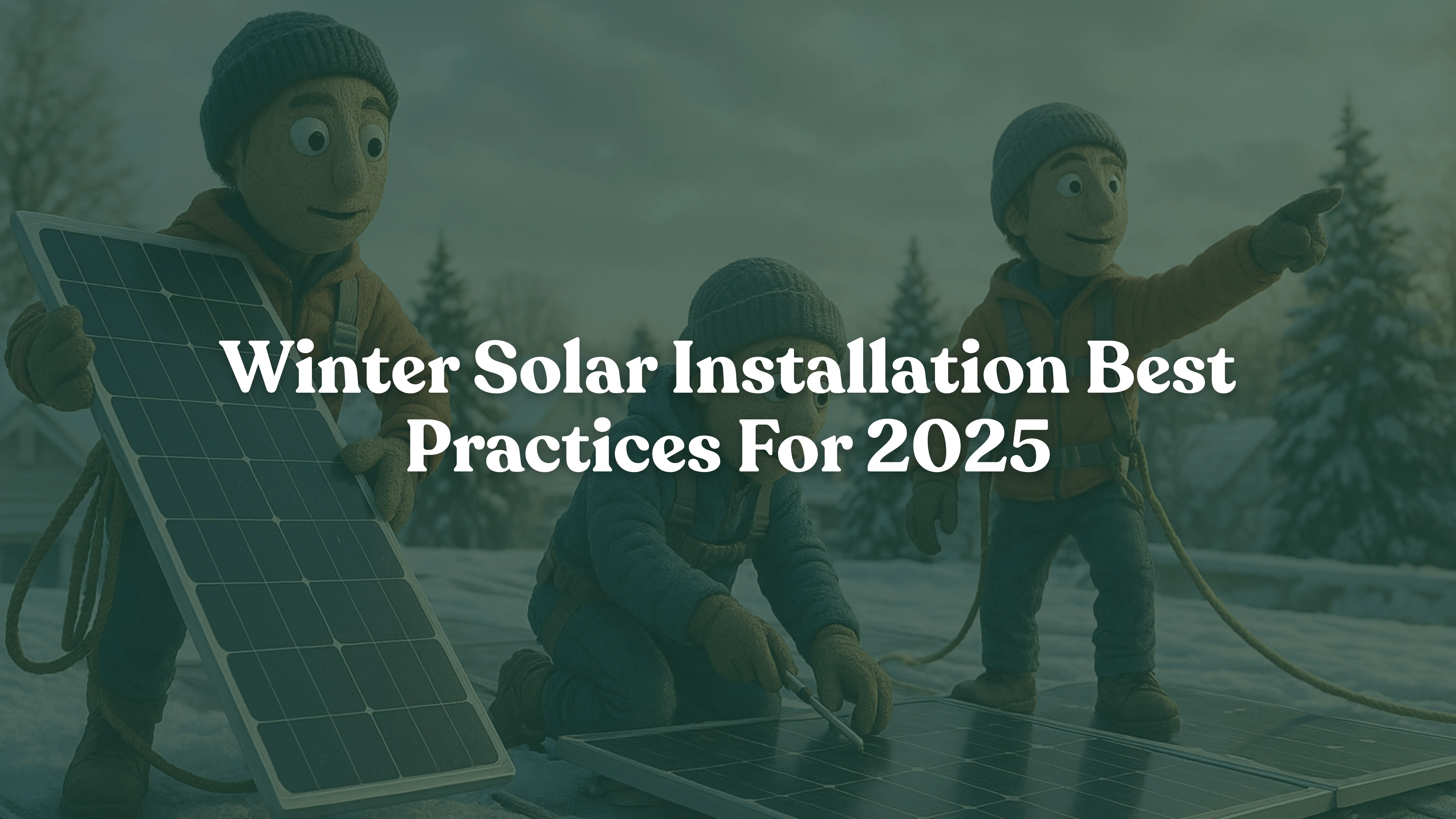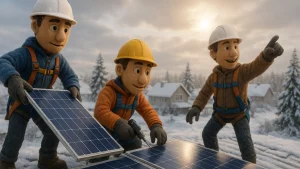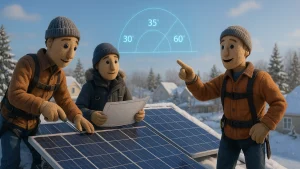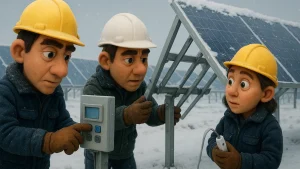Winter Solar Installation: Safety & Performance Guide For 2025

Winter Solar Installation Best Practices: Maximizing Safety and System Performance in Snow-Prone Regions
Winter solar installation doesn’t have to slow down your business. While many contractors view snowy months as off-season, mastering cold-weather solar panel installation opens year-round revenue opportunities. With solar photovoltaic installer jobs projected to grow 51% by 2029 according to the U.S. Bureau of Labor Statistics, demand for winter solar installation expertise is soaring across snow-prone regions throughout the United States.

The key to successful winter solar installation isn’t avoiding cold weather—it’s implementing proper safety protocols, design strategies, and installation techniques that protect your crew while maximizing system performance. This comprehensive guide covers everything solar installers and EPCs need to know about winter installations in snow-heavy climates.
How Does Cold Weather Affect Solar Panel Efficiency?
Here’s a fact that surprises many clients: solar panels actually perform more efficiently in cold temperatures than in hot weather. According to the U.S. Department of Energy, PV modules operate more efficiently in colder conditions because temperatures above 77°F cause voltage decreases.
The challenge with winter solar installation isn’t panel performance—it’s the installation process itself. Snow accumulation, ice formation, and frigid temperatures create unique obstacles that require specialized knowledge and equipment.

The Winter Performance Reality
While panels love cold temperatures, winter brings:
- Shorter daylight hours reducing total energy capture
- Temporary production stops when snow covers panels
- Ice accumulation that can stress mounting structures
- Reduced battery capacity in extreme cold
The good news? Most snow melts quickly off solar systems or gets blown away by wind, and the albedo effect from ground snow can reflect extra sunlight onto panels, sometimes creating surprising production boosts on clear winter days.
What Safety Measures Are Essential for Winter Solar Installation?
Safety is non-negotiable in winter solar installation. Between 2011 and 2019, 650 solar PV installers were injured on the job, with challenging weather conditions contributing to many incidents. OSHA’s solar safety guidelines emphasize heightened protocols for cold-weather work.
Critical Winter Safety Protocols
Fall Protection in Icy Conditions: Winter solar installation amplifies standard fall hazards. Implement these measures:
- Anti-slip footwear with aggressive tread designed for ice
- Modified fall arrest systems accounting for bulkier winter clothing
- Roof surface preparation including de-icing before crew access
- Guardrail systems with enhanced stability for snow loads
Cold Weather Health Considerations: Protect your crew from hypothermia and frostbite:
- Shorter work rotations (45-minute maximum in extreme cold)
- Heated break areas on-site
- Insulated, moisture-wicking base layers
- Hot beverage availability throughout shifts
- Buddy system monitoring for cold-stress symptoms
Electrical Safety in Winter: Cold weather introduces unique electrical risks:
- Reduced flexibility in cables and connections
- Ice formation around junction boxes
- Static electricity buildup in dry, cold air
- Tool performance changes in extreme temperatures
Weather Monitoring: Never compromise on conditions. Track wind chill, precipitation forecasts, and visibility. If conditions deteriorate during installation, secure the site and resume when safe.
Design Considerations for Snow-Heavy Regions
Smart design prevents costly problems. Winter solar installation success starts with engineering that accounts for regional snow loads and ice accumulation.
Optimal Tilt Angles for Snow Shedding
The Department of Energy recommends tilt angles of 30-35 degrees for significant snow shedding improvements in winter solar installation projects. Steeper angles up to 60 degrees provide even better shedding, though they may reduce summer production.
Your design must balance:
- Snow shedding capability
- Optimal annual energy production
- Wind load impacts (steeper = higher wind loads)
- Roof structure limitations

Structural Loading Requirements
Snow adds tremendous weight. A cubic foot of wet snow can weigh 20+ pounds. Your winter solar installation design calculations must:
- Meet or exceed local snow load codes from ASCE 7 standards
- Categorize solar racking as “ice-sensitive structures” requiring additional safety factors
- Account for drift loading where wind creates snow accumulation patterns
- Consider combined loads including snow, wind, and seismic requirements
Frame Selection and Snow Performance
Research from the National Renewable Energy Laboratory shows frameless modules shed snow significantly faster than framed alternatives. Under heavy snow loads, frames can detach from modules, creating safety hazards and system damage.
For winter solar installation in heavy snow areas:
- Prioritize frameless panel options when possible
- If using framed panels, specify reinforced frame-to-module attachments
- Calculate worst-case frame loading scenarios
- Consider multi-busbar cell technology to minimize crack propagation under stress
Installation Techniques for Cold Weather Success
Proper execution separates successful winter solar installation from problematic projects. Temperature affects materials, tools, and human performance.

Temperature-Dependent Materials
Sealants and Adhesives: Most sealants require minimum temperatures for proper curing. Check manufacturer specifications and:
- Schedule sealing work during warmest parts of the day
- Use “winter-grade” sealants rated for low temperatures
- Allow extended curing time in cold conditions
- Store materials at room temperature until use
- Never apply sealants to frozen or wet surfaces
Electrical Components: Battery systems and inverters have temperature operating ranges:
- Lithium batteries may require heated enclosures below 32°F
- Inverters need adequate ventilation even in winter
- Connection torque specifications may differ in cold temperatures
- Wire insulation becomes brittle in extreme cold
Foundation Considerations for Ground-Mount Systems
Winter solar installation in cold climates must address frost heave—the phenomenon where freezing ground pushes foundations upward. This can topple ground-mounted systems if not properly designed.
Frost Heave Prevention:
- Extend pile depth significantly below local frost depth
- Require engineering calculations specific to frost heave forces
- Use helical piers designed for cold-climate stability
- Consider insulated foundation designs for extreme regions
- Work with engineering firms experienced in cold-climate solar installations
Water Management and Ice Dam Prevention
Water entering electrical enclosures can freeze, expand, and destroy components. Winter solar installation waterproofing is critical:
- Specify NEMA 4 or higher-rated enclosures
- Apply silicone-based sealants around all mounting brackets
- Install rubber gaskets at cable entry points
- Use UV-resistant cable ties rated for temperature extremes
- Ensure drainage paths remain clear to prevent ice dams
- Position roof-mounted modules to avoid ice backup under shingles
Tracker Systems in Winter Solar Installation Projects
Solar tracker systems require special consideration for winter solar installation in snow-prone regions. Many modern trackers offer “snow stow” modes that automatically tilt panels to steep angles during heavy snow events.
Tracker Design Requirements
Snow Stow Functionality:
- Automatic activation when snow sensors detect accumulation
- Manual override capability for anticipated storms
- Worst-case structural design assuming stow function fails
- Communication backup systems ensuring reliable operation

Structural Considerations: Trackers mount panels at their center, leaving ends less supported. This creates stress concentration points under snow loads. Your winter solar installation design must:
- Specify tracker systems with proven winter performance records
- Add structural reinforcement beyond standard specifications
- Calculate loading scenarios with uneven snow distribution
- Plan maintenance access for snow removal if required
Advanced Technology for Winter Solar Installation
Modern solutions make winter solar installation safer and more efficient.
Snow Management Technologies
Heated Panel Systems: Low-voltage heating cables installed at panel edges can prevent snow accumulation. While consuming minimal electricity, these systems can increase winter production by up to 30% in heavy snow regions according to recent performance studies.
Smart Monitoring: Real-time monitoring helps identify:
- Snow coverage reducing production
- Ice formation on mounting structures
- Performance degradation from cold-related issues
- Crew safety conditions through weather integration
Wire Management Solutions
As snow melts and refreezes, icicles form and add weight to system components. Use wire management rated for:
- Additional weight from ice accumulation
- Temperature cycling without becoming brittle
- UV exposure even in winter months
- Easy inspection during maintenance
Client Education: Setting Winter Solar Installation Expectations
Transparent communication prevents misunderstandings. When discussing winter solar installation with clients, address:
Performance Expectations:
- Winter production will be 30-40% lower due to shorter days
- Snow coverage temporarily stops production (typically only days per year)
- Cold temperatures actually boost panel efficiency
- The albedo effect can create production spikes after snowfall
Maintenance Requirements:
- Most systems are self-clearing through tilt and panel heat
- Heavy, wet snow may require professional snow removal
- Never allow clients to climb roofs for snow removal
- Professional maintenance preserves warranties
Long-Term Value:
- Annual production matters more than winter-only production
- Net metering captures summer surplus for winter use
- Battery storage bridges production gaps
- System longevity depends on proper winter design
Mastering Winter Solar Installation for Year-Round Success
Winter solar installation represents both challenge and opportunity. The technical demands are real—proper safety protocols, specialized design considerations, and temperature-aware installation techniques aren’t optional. But contractors who master winter work position themselves for sustained growth in an increasingly competitive solar industry.
The fundamentals remain constant: protect your crews, engineer systems for real-world conditions, and deliver reliable performance regardless of season. Whether you’re installing in light snow regions or heavy accumulation zones, following these winter solar installation best practices ensures safety, quality, and profitability.
The solar industry isn’t slowing down, and neither should your installation schedule. Start building winter capability today, and you’ll reap rewards throughout every season tomorrow.
Ready to expand your winter solar installation capabilities? Contact our team for specialized training resources or explore our complete solar installation resource library.

sjayakanth@energyscaperenewables.com